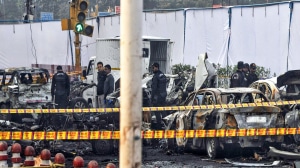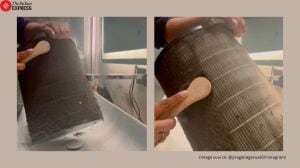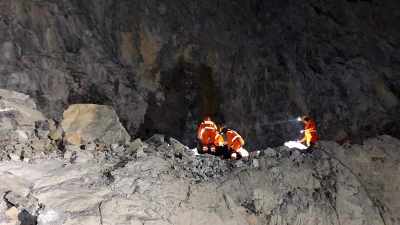Stay updated with the latest - Click here to follow us on Instagram
Big Picture: Face two
As the machine pulled her head back, it took just a few seconds for the skin of her face and scalp to tear off and come apart in two pieces.
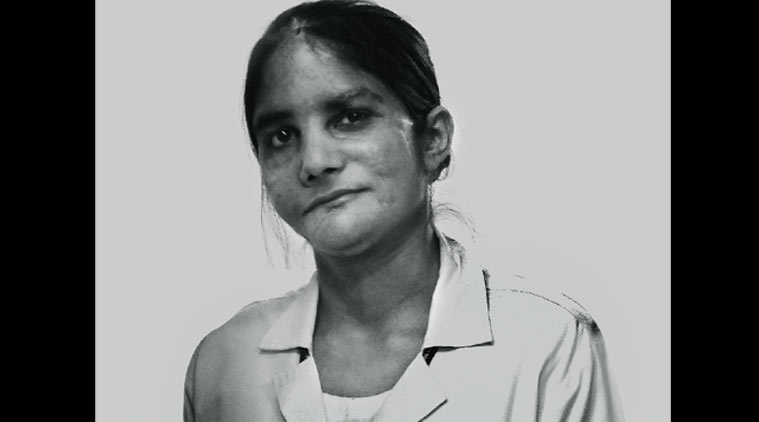 Sandeep Kaur
Sandeep Kaur
Next month, the world’s first full-face replant patient will become a mother. Rakhi Jagga meets Sandeep Kaur and her remarkable doctor Abraham Thomas
Face Replant: A face replant is a procedure that reconnects the blood vessels, nerves, bones, muscles and other supportive structures to the skin of a person damaged in a mishap. Unlike a face transplant, which relies on an external donor, a face replant uses the skin and grafts from the person undergoing the procedure.
The procedure: The damaged skin is first stored in ice and kept aside. The 8 cranial and 14 facial bones are shifted to specific positions if they have been damaged. A surgical microscope then connects the 17 major facial arteries and 7 primary veins to begin the blood circulation. Finally, the 40 facial muscles are connected and the skin is sutured back on. If the skin if severely damaged, grafts from the patient’s back, buttocks, thighs, or chest are used. The structurally complex eyelids and mouth are the toughest to replant and involve complications.
The risks: There is a risk of a clot blocking the blood supply to the newly sewn face and killing the replanted tissues. A series of recontructive surgeries are needed after the first operation, which takes between 2 and 10 hours.
The next step: The world’s first partial face transplant on a living human was carried out on November 27, 2005, in France. Isabelle Dinoire underwent surgery to replace her original face, which had been mauled by her dog. On March 20, 2010, a team of 30 Spanish doctors carried out the world’s first full face transplant, on a man injured in a shooting accident.
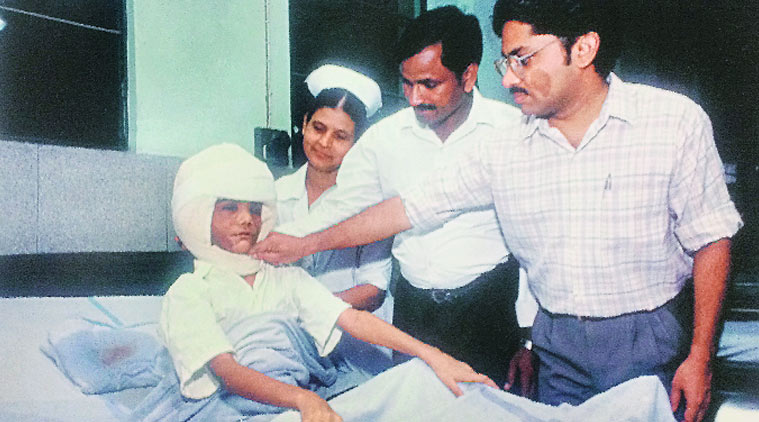 Sandeep at nine, soon after her surgery. She has undergone six operations and a dozen-odd “touch-ups” since — almost every other year except the times she had to skip due to exams or other engagements.
Sandeep at nine, soon after her surgery. She has undergone six operations and a dozen-odd “touch-ups” since — almost every other year except the times she had to skip due to exams or other engagements.
Sometime towards the end of July, Sandeep Kaur will become a mother. Twenty-one years after what the NYU School of Medicine calls “the world’s first full-face operation” came bleeding to Ludhiana’s Christian Medical College and Hospital with her face in two pieces, she will be wheeled into hospital for her first medical procedure that wouldn’t involve her face.
Dr Abraham Thomas will not be in the room, but he is unlikely to be far away. This is the story of a girl, a doctor, and a 21-year-long association to give her her old face and a new life.
It’s the scream that Sandeep remembers most vividly. And it wasn’t even hers. It was a July afternoon in their Chak Shekhupura Khurd village in Malerkotla, muggy and quiet. June 1994 had been very hot, and the temperature had just started falling. The only sound around at that time of the day on July 23, Saturday, was that of the thresher machine, kept in the open area of the house, next to which the nine-year-old and her cousin sat, cutting grass.
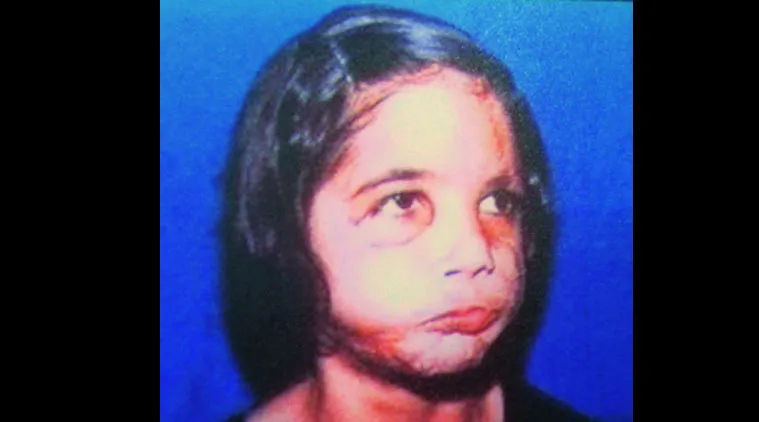 After little Sandeep recovered from her face replant, she went back to school and topped her class
After little Sandeep recovered from her face replant, she went back to school and topped her class
Sandeep was proud of how well she operated the manual handle starter that controlled the thresher’s speed. Around 3.30 pm, her attention slipped for a moment, there was the sudden pull of air pressure and a tug, and her long pigtails got swept into the motor of the thresher. As the machine pulled her head back, it took just a few seconds for the skin of her face and scalp to tear off and come apart in two pieces.
“I stood up. I had no idea what had happened. I was feeling no pain at all, my face totally numb,” Sandeep remembers. “I walked towards my mother who had her back towards me. Tapping her on the shoulder, I asked, ‘Mumma, meinu ki hoya hai (what’s happened to me)?’. She turned, saw my bleeding face with no skin, and screamed aloud.”
Within minutes, almost the entire village had gathered. Sandeep’s father Sudagar Singh, who worked in the Irrigation Department then, was away at office, having been summoned for some urgent work on his day off.
“Mumma was dazed, she didn’t know what to do. A neighbour wrapped my face in a sheet, while the village’s rural medical practitioner, Harjinder Singh, rushed me to Malerkotla Civil Hospital, a 15-minute drive, in his jeep,” Sandeep says.
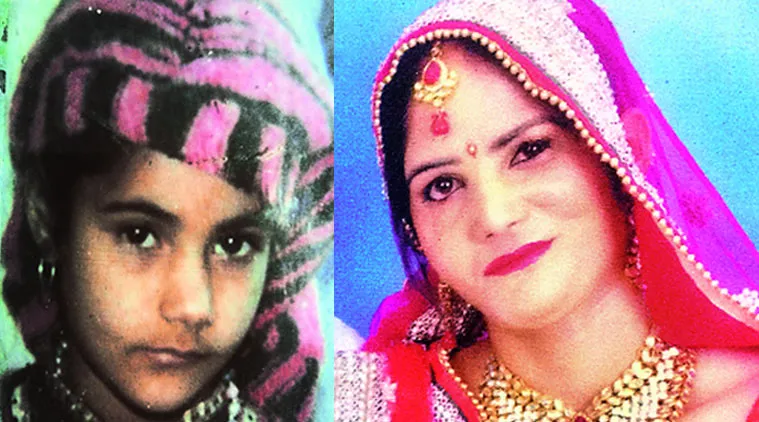 The precautions she takes while applying make-up were relaxed for her September 2014 wedding
The precautions she takes while applying make-up were relaxed for her September 2014 wedding
One of the doctors there showed a fortuitous presence of mind. He immediately sent Sandeep’s relatives back to fetch her peeled skin. Sandeep’s chacha Avtar Singh, also the sarpanch of the village, raced to the village and got the two pieces in a polybag. The doctors at the Civil Hospital put the pieces in ice and advised Sandeep’s family to take her to Dayanand Medical College and Hospital. From there, they were referred to the Christian Medical College and Hospital (CMCH), Ludhiana.
It had already been three hours since the accident by then. Around 6.30 pm, renowned microvascular surgeon Dr Abraham Thomas saw Sandeep for the first time. Over the next 10 hours, the surgeon and his team would reconnect Sandeep’s arteries and veins with her torn skin.
Dr Thomas, who is now the director of CMCH, was not sure Sandeep would survive the operation. No one present surely imagined they were about to make history as the first reported full-face replant.
A similar operation would be conducted next more then two years later, in the Australian state of Victoria. It would take another nine years for the world’s first partial face transplant to be done, in France, while the first full face transplant would have to wait till 2010, Spain.
In the section of the surgical ward at CMCH with the very critical cases, Sandeep works quietly and efficiently, adjusting the IV drip of a patient. In the third trimester of her pregnancy, the staff nurse has been given “easier” hours in the colourful paediatric OPD — located on the first floor of CMCH, just two floors down from where Sandeep has spent a large part of her life as a patient.
Nursing superintendent Reena Jairus is proud of her young ward. “Sandeep has details of patients on her fingertips, she is skillful and communicative, and her attitude is very positive. She counsels patients well,” says Jairus.
As for her past, Sandeep hardly discusses that, the superintendent adds. “The only time we spoke a little about her accident was when she sought leave for a week for a recontructive surgery.”
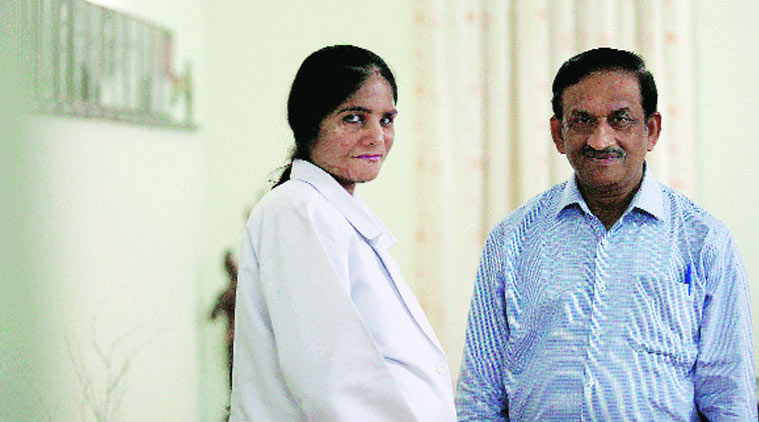 Dr Abraham Thomas (right) has been by Sandeep’s side ever since he performed the first reconstruction surgery on her face. (Source: Express photo by Gurmeet Singh)
Dr Abraham Thomas (right) has been by Sandeep’s side ever since he performed the first reconstruction surgery on her face. (Source: Express photo by Gurmeet Singh)
Colleague Rose Mary, who used to work with Sandeep in the surgical ward, says the 30-year-old isn’t one to look for sympathy. “Once I asked her about the scars on her face. She just told me she had met with an accident at the age of nine. I never asked her anything after that.”
After the surgery in 1994 and through the years of recovery, Sandeep was never in doubt that this was where she would head after growing up.
In 2004, she took admission in a Punjab nursing college. When Dr Thomas moved south as principal of the prestigious Pondicherry Institute of Medical Sciences (PIMS), she shifted there. Since she needed successive recontructive surgeries to reduce her scar lines, this was agreed upon as the best course.
The doctor returned to CMCH in 2008 as director, and the next year, Sandeep, after completing her nursing degree, joined as a staff nurse at the hospital.
Says Jairus, “Most of the staff knows about Sandeep’s surgery. But it can happen to anyone; it was just an accident. Sandeep is like any another nurse.”
In the days that followed the July 1994 operation, Sandeep’s recovery was good, but unpredictable. “The doctors first re-attached the right part of the face, and then the left. Both started receiving good blood supply within three days; Sandeep responded well. Our daughter was back,” says Saudagar Singh.
Hailing the “miracle”, he adds, “At the time of the accident, my family or the villagers had no idea what to do with Sandeep’s torn skin. They left it at home thinking it was useless; a few even advised that it be thrown away. Thank God, we did not do so.”
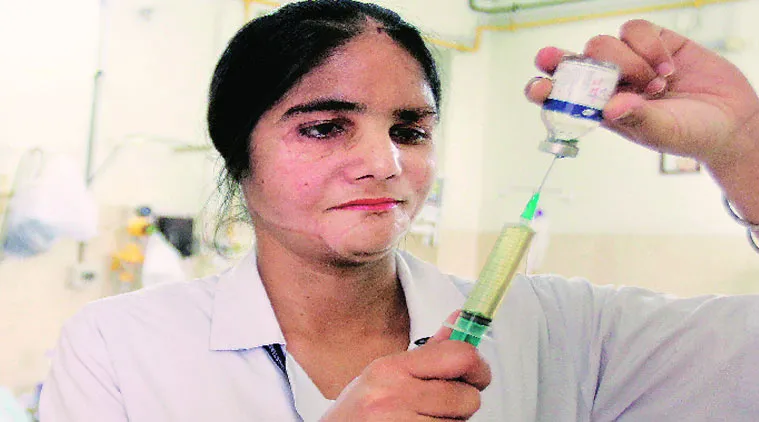 Sandeep, who returned as nurse to the hospital where she was operated upon, doesn’t talk much about her face replant with her colleagues. (Source: Express photo by Gurmeet Singh)
Sandeep, who returned as nurse to the hospital where she was operated upon, doesn’t talk much about her face replant with her colleagues. (Source: Express photo by Gurmeet Singh)
Sandeep stayed in hospital for two and a half months. In the first 45 days, she could not speak or see, with stitches all over her face. Saudagar gave her a small notebook, in which she would scribble what she wanted to say or whom she wanted to meet. She would identify her visitors by touch.
Sandeep was also kept on IV fluids and had to take medicines by injection as she could not eat or drink. Even when the stitches came off after one-and-a-half months and she could see, she was still not allowed to eat or talk much.
It was by end-October 1994, that she finally started speaking and eating normally.
Within days, Sandeep recalls proudly, she was back at school. “I used to go to her home as well to teach her, and she picked up things fast. She stood first in Class IV like previous years. We are all proud of her,” says Parkash Singh,one of Sandeep’s teachers from then.
Her face was badly scarred at that time, and Sandeep admits many children couldn’t help but stare at her. However, soon, she said, they were treating her like any other child.
Saudagar doesn’t remember Sandeep ever going into depression or trauma, even during the hospital trips every two months. Instead, often she insisted on staying back at the hospital rather than going home.
While they were all there to counsel her, Saudagar says, “Sandeep was very strong herself. She used to say whatever has happened has happened.” And then there was always Dr Thomas.
“To me what’s unbelievable is that the doctor who gave a new life to her has also rehabilitated her,” says Sandeep’s mother Harpal Kaur. Dr Thomas had already done a full transplant of the scalp before Sandeep’s case came to him. “A full scalp and face replant was something we were doing for the first time,” he remembers.
Senior microsurgeon technician Rattan Masih, whom Sandeep calls ‘Rattan Uncle’, was part of the team that operated upon Sandeep the first time, along with two other technicians, Bannu Ram and David Masih. “We used to tell her stories while changing her bandages every four-five days,” Rattan Masih laughs.
Plastic surgeon Dr Vijay Obed, who also assisted Dr Thomas, talks about the American College of Surgeons calling Sandeep’s case a milestone in a journal celebrating their 100 years.
In the 21 years since her accident, Sandeep has undergone about six major surgeries. That’s apart from the dozen-odd “touch-ups” to reduce the scar lines — almost every other year except the times she had to skip due to exams or other engagements.
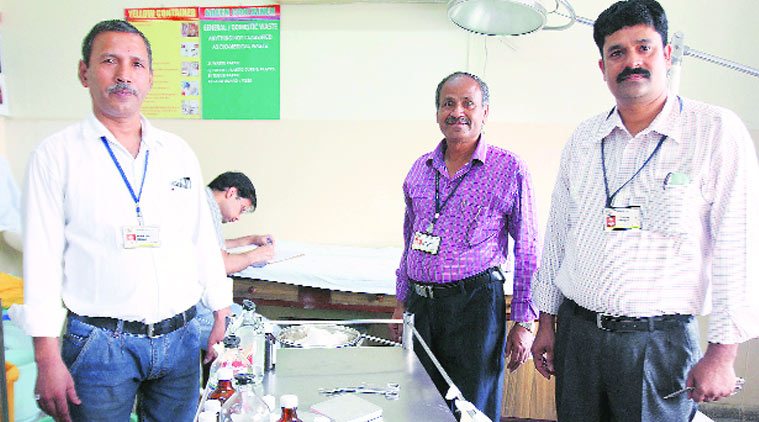 David Masih, Rattan Masih and Bannu Ram were the microsurgeon technicians when she was operated upon. They would tell her stories while changing her bandages every few days, they say. (Source: Express photo by Gurmeet Singh)
David Masih, Rattan Masih and Bannu Ram were the microsurgeon technicians when she was operated upon. They would tell her stories while changing her bandages every few days, they say. (Source: Express photo by Gurmeet Singh)
While the cost of the first surgery in 1994 was Rs 60,000, till now the family has spent around Rs 7 lakh on Sandeep, after discounts from the hospital. Dr Thomas was present at each of the big surgeries.
If a wall in his office proudly displays Sandeep’s case, the Singhs too keep him as close as family. Dr Thomas is present in photos of most festivities at the Singh home, especially Sandeep’s birthdays.
About five years ago, when Sandeep’s family started looking for a boy, they found Gurpreet Singh through a matrimonial advertisement in the newspaper. Sandeep’s family told Gurpreet’s about her accident. Gurpreet expressed willingness to meet Sandeep, and later to marry her. But, says Sandeep’s family, they approved the match only after Dr Thomas had met Gurpreet personally and given the go-ahead.
“We trust Dr Thomas blindly and after placing the matrimonial ad, we often consulted him on the correct match for our daughter,” says Harpal Kaur.
Gurpreet later got job as a biomedical engineer in CMCH as well. The September 2014 wedding was attended by all the doctors who had been present at Sandeep’s 1994 operation. “She got a good match indeed,” smiles Rattan.
Getting ready that big day though was a bit of an issue. While Sandeep is not required to take medicines any more, says Dr Thomas, she has to take certain precautions with make-up and after removing it. Finally, it was decided, a concession could be made for the wedding.
So her mother and relatives applied haldi ubtan on her like any other bride and later she went to a parlour to get ready.
Apart from make-up, the only thing she has to be careful about is to protect her face for four-six weeks after every recontructive surgery. “I take leave for a week to get the surgery done. The swelling on my face remains for about a week and, later, I have to stay away from heat, avoid cooking, not rub the skin too hard, etc. I follow the precautions by heart… they are not so difficult,” she says.
Dr Thomas agrees. “She no longer needs to be told about the dos and don’ts. Sandeep follows them herself.” A part of the skin had been taken from her forelimbs for the recontructive surgery, but only scars are left there now.
There has been a gap in the recontructive surgeries the past year because of first Sandeep’s pregnancy and now her forthcoming delivery. But she isn’t worried. “My husband loves me the way I am. He says he has no problem with my scars and I can skip all the recontructive surgeries now. However I want to get a little correction done in my face near the left part of my chin and eye. Hopefully I will get it done after I have my baby,” she smiles.
Gurpeet, who worked in Barwala in Haryana before marriage, says his life has changed for the better. “We are working in the same organisation and we understand each other’s responsibilities. Sandeep is a responsible woman, she is ‘super intelligent’. I am very happy,” says the shy 27-year-old.
All of the family’s attention is focused on the baby now. “You cannot believe how happy I am. I am going to be a grandfather soon. Who wants to remember that ill-fated day again?” Saudagar says.
Moved by Sandeep’s story, her brother Harsimrat Singh pursued science. After post-graduation, he now works as a teacher in a private school near their village.
Ask her if she sees herself as an inspiration, and Sandeep says she would consider it so if her story “can motivate even a single life”.
She is no longer afraid of anything, she adds, not even threshers. “If I can live a normal life, many others can do so too. One needs to have strong will power and of course get timely and best medical help.”
Normal, in fact, is a word that often comes up when Sandeep talks about herself now. “I have normal vision, I can eat properly, I can make hairstyles of my long hair, the way I want. In short, I am just a normal girl,” she says. “I no longer carry the baggage of the past. There is a beautiful life ahead.”
With one change, intervenes Saudagar. She has to keep her hair tied well. “Yes, this precaution I need to follow for life,” Sandeep laughs.
Dr Thomas is a satisfied man. “Sandeep came to me as a child… Now she is a big girl.”


